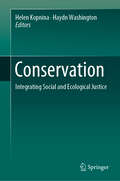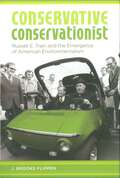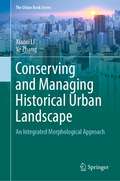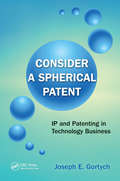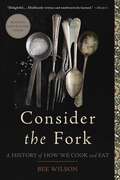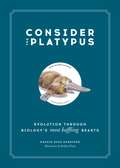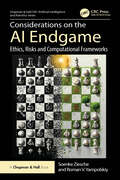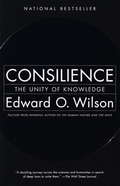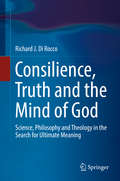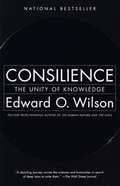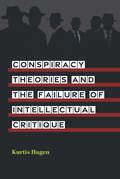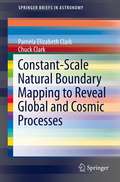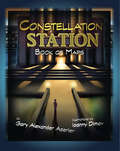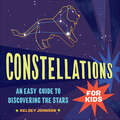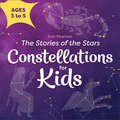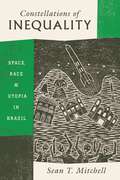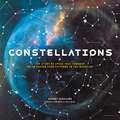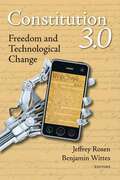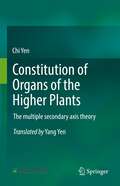- Table View
- List View
Conservation: A Beginner's Guide (Beginner's Guides)
by Paul Jepson Richard LadleThe need to protect nature has never been so pressing. As unprecedented environmental challenges threaten to wipe out many of the planet's species, there is a battle against time to formulate new ways of defending nature. Jepson and Ladle cover all aspects of modern conservation from inspiring successes to the most urgent crises, introduce exciting new techniques such as re-wilding and adaptive management, and explain how we can all contribute. Essential reading for anyone who does not want to see the last of pandas, polar bears, and parrots. Dr. Paul Jepson and Dr. Richard Ladle both work at the University of Oxford.
Conservation: Integrating Social and Ecological Justice (Routledge Explorations In Environmental Studies)
by Helen Kopnina Haydn WashingtonThis book provides keys to decrypt current political debates on the environment in light of the theories that support them, and provides tools to better understand and manage environmental conflicts and promote environmentally friendly behaviour. As we work towards global sustainability at a time when efforts to conserve biodiversity and combat climate change correspond with land grabs by large corporations, food insecurity, and human displacement. While we seek to reconcile more-than-human relations and responsibilities in the Anthropocene, we also struggle to accommodate social justice and the increasingly global desire for economic development. These and other challenges fundamentally alter the way social scientists relate to communities and the environment. This book takes as its point of departure today’s pressing environmental challenges, particularly the loss of biodiversity, and the role of communities in protected areas conservation. In its chapters, the authors discuss areas of tension between local livelihoods and international conservation efforts, between local communities and wildlife, and finally between traditional ways of living and ‘modernity’. The central premise of this book is while these tensions cannot be easily resolved they can be better understood by considering both social and ecological effects, in equal measure. While environmental problems cannot be seen as purely ecological because they always involve people, who bring to the environmental table their different assumptions about nature and culture, so are social problems connected to environmental constraints. While nonhumans cannot verbally bring anything to this negotiating table, aside from vast material benefits that society relies on, the distinct perspective of this book is that there is a need to consider the role of nonhumans as equally important stakeholders – albeit without a voice. This book develops an argument that human-environmental relationships are set within ecological reality and ecological ethics and rather than being mutually constitutive processes, humans have obligate dependence on nature, not vice versa. This would enable an ethical position encompassing the needs of other species and giving simultaneous (without one being subordinated to another) consideration to justice for humans and non-humans alike. The book is accessible to both social scientists and conservation specialists, and intends to contribute to strengthening interdisciplinary collaborations in the field of conservation.
Conservative Conservationist: Russell E. Train and the Emergence of American Environmentalism
by J. Brooks FlippenIn the history of American environmentalism, Russell E. Train plays a starring role. Few individuals have been so influential in creating the United States' environmental policies and encouraging conservation efforts around the world. In this absorbing new biography, J. Brooks Flippen describes Train's significance within the fascinating history of the contemporary environmental movement.A lifelong Republican, Train left a successful judicial career to found the African Wildlife Leadership Foundation. As the problems of pollution and unrestrained growth became apparent, he adopted a more ecological approach to nature and became a leader of the emerging environmental movement of the 1960s. He soon headed the Conservation Foundation, one of the first organizations to appreciate that humans represent only one strand in the "web of life." President Richard Nixon appointed Train as the initial chairman of the Council on Environmental Quality just as the country celebrated its first Earth Day. There he helped craft the most important environmental legislation in U.S. history. After three years, he became administrator of the Environmental Protection Agency, enforcing regulations during the Energy Crisis and much of the troubled 1970s.With the election of Democrat Jimmy Carter, Train returned to the private sector as head of the American affiliate of the World Wildlife Fund. He found himself increasingly at odds with many Republicans as a new, more ideological brand of conservatism grew and bipartisanship faded. Train's Republican credentials and environmental advocacy made him a vestige of the past and, in a sense, a hope for the future.Given complete access to the personal papers and recollections of Russell Train, Flippen casts an unbiased eye on this remarkable man and the causes he has so fervently promoted. Of a prominent Washington family, Train has known every president from Herbert Hoover to George W. Bush. His life and career illustrate the political dynamics of modern environmentalism and illuminate the insider culture of Washington, D.C.
Conserving Biocultural Landscapes in Malaysia and Indonesia for Sustainable Development
by Sun-Kee Hong Saiful Arif Abdullah Amin Setyo LeksonoThis book presents perspective on the importance of natural and cultural relationships for conserving bio-cultural landscapes. It explores the approaches and concepts used to conserve bio-cultural landscapes in Malaysia and Indonesia. The book highlights the importance of bio-cultural landscape in sustainable development framework and its link to sustainable development goals are also included. It fills the gap in literature with special focus on this region. The book is of interest to teachers, researchers, climate change scientists, conservationists, capacity builders and policymakers. Also it serves as additional reading material for undergraduate and graduate students of ecology, and environmental sciences. National and international environmental scientists, policy makers also find this to be a useful read.
Conserving and Managing Historical Urban Landscape: An Integrated Morphological Approach (The Urban Book Series)
by Xiaoxi Li Ye ZhangThis book focuses on urban morphology and its application to urban conservation and management. The rapid disappearance of historical urban landscapes, especially in developing countries, is largely attributed to the lack of historic awareness and broad-brush demolition and redevelopment in urban development. The book provides a new, integrated morphological approach that enables fine-grained and cross-scale examination of urban form based on both its historicity and socio-economic potential, with the aims of informing more responsive and context-specific conservation and management of historical urban landscapes. The robustness of this new approach and the feasibility of its application to urban conservation practice are tested and demonstrated by three case studies in drastically different cultural contexts, namely Ludlow, a medieval town in the UK, Chinatown in Singapore and a historic quarter in Nanjing, China. Combining historico-geographical and configurational approaches, the book also makes a significant breakthrough in terms of coordinating and synthesizing different traditions of urban morphology, which has been a key challenge to this field over the past decades. In addition, by using multi-source data, ranging from conventional cartographic maps to computer-generated and open online data, the integrated approach innovatively relates qualitative and quantitative aspects of urban form and links the qualitative and quantitative analyses of formal structure. As an interdisciplinary study merging geography, urban history, urban planning and design, this book is to be primarily used as a reference book for graduate students and scholars in various fields who are interested in urban form and urban conservation and management. In addition, it offers practitioners in urban planning and design a useful tool for managing changes in historical urban landscapes. Lastly, it contributes to developing a common platform to facilitate dialogues among various stakeholders and participants in urban conservation practice.
Consider a Spherical Patent: IP and Patenting in Technology Business
by Joseph E. GortychGet Critical Insight into the Modern Patenting Scene We are now living in the "IP Era of the Information Age" where technology businesses are placing increasing emphasis on intellectual property (IP) as a way to add to their bottom lines. As a consequence, those working in a technology business or organization will inevitably be thrust into working
Consider the Fork: A History of How We Cook and Eat
by Bee WilsonSince prehistory, humans have striven to tame fire and ice, and have braved the business ends of mashers, scrapers, and razor-sharp knives--all in the name of creating something delicious (or, at least, edible). The technology of food matters even when we barely notice it is there, but in recent years kitchen technology has become increasingly elaborate and eye-catching, transforming the old-fashioned home kitchen into a bristling stainless steel laboratory. Far from a new development, however, the modern kitchen is only the most recent iteration of an ancient lineage of food technology, as acclaimed food historian Bee Wilson reveals in Consider the Fork. Many of our technologies for preparing food have remained strikingly consistent for thousands of years. The Greeks and Romans already had pestles and mortars. Knives--perhaps mankind's most important gastronomic tool--predate the discovery of that other basic technology, fire. Other tools emerged quite suddenly (like the microwave, whose secrets were unlocked during radar tests conducted during World War II) or in fits and starts (like the fork, which had to endure centuries of ridicule before finally gaining widespread acceptance). For every technology that has endured, others have fallen by the wayside. We no longer feel the need for andirons and bastables, cider owls and dangle spits, even though in their day these would have seemed no more superfluous than our oil drizzlers and electric herb choppers. The evolution of food technology offers a unique window into human history, and Wilson blends history, science, and personal anecdotes as she traces the different technologies that have shaped--or slashed, pounded, whisked, or heated (and reheated)--our meals over the centuries. Along the way she reveals some fascinating facts--showing, for instance, how China's cuisine, its knives, and its eating utensils are all the product of the country's historically scarce fuel supply. To conserve energy, chefs rendered their ingredients quick-cooking by using large, multi-purpose chopping knives to reduce food to small, bite-sized morsels. This technique, in turn, gave rise to the chopstick, which cannot cut. What's more, the discovery of the knife--in Asia and elsewhere--was likely what gave humans our distinctive overbite. Before humans learned to fashion knives out of sharpened rocks, many of us cut our food by clamping it in our front teeth, which gave us perfectly aligned rows of teeth. But Wilson shows that, far from being adventurous innovators, cooks are a notoriously conservative bunch, and only adopt new technologies with great reluctance. The gas range revolutionized cooking when it was first introduced in the 19th century by promising to end "hearth deaths," a constant danger for women wearing billowing, flammable clothing. But indoor gas cooking--safer and more efficient--was nevertheless greeted with widespread suspicion when it was first introduced. Many chefs feared it would taint their food or poison their guests. The same hold true for the refrigerator, which was initially condemned as an unnatural technology that risked changing the fundamental "essence" of food. Perhaps the one exception to this technophobia, says Wilson, was the egg beater, new patents for which proliferated so astonishingly in late 19th-century America. In this fascinating history, Wilson reveals the myriad innovations that have shaped our diets today. An insightful look at how we've changed food and how food has changed us, Consider the Fork reveals the astonishing ways in which the implements we use in the kitchen affect what we eat, how we eat, and how we relate to food.
Consider the Platypus: Evolution through Biology's Most Baffling Beasts
by Maggie Ryan Sandford*FINALIST FOR THE 2020 GENERAL NONFICTION MINNESOTA BOOK AWARDS*Interested in the origins of the species? Consider the Platypus uses pets such as dogs and cats as well as animal outliers like the axolotl and naked mole rat to wittily tackle mind-bending concepts about how evolution, biology, and genetics work.Consider the Platypus explores the history and features of more than 50 animals to provide insight into our current understanding of evolution. Using Darwin's theory as a springboard, Maggie Ryan Sandford details scientists' initial understanding of the development of creatures and how that has expanded in the wake of genetic sequencing, including the:Peppered Moth, which changed color based on the amount of soot in the London air;California Two-Spotted Octopus, which has the amazing ability to alter its DNA/RNA not over generations but during its lifetime;miniscule tardigrade, which is so hearty it can withstand radiation, lack of water and oxygen, and temperatures as low as -328°F and as high 304 °F;and, of course, the platypus, which has so many disparate features, from a duck's bill to venomous spur to mammary patches, that scientists originally thought it was a hoax. Surprising, witty, and impeccably researched, Sandford describes each animal's significant features and how these have adapted to its environment, such as the zebra finch's beak shape, which was observed by Charles Darwin and is a cornerstone of his Theory of Evolution. With scientifically accurate but charming art by Rodica Prato, Consider the Platypus showcases species as diverse as the sloth, honey bee, cow, brown kiwi, and lungfish, to name a few, to tackle intimidating concepts is a accessible way.
Considerations on the AI Endgame: Ethics, Risks and Computational Frameworks (Chapman & Hall/CRC Artificial Intelligence and Robotics Series)
by Soenke Ziesche Roman V. YampolskiyThis seminal volume offers an interdisciplinary exploration into the rapidly evolving field of artificial intelligence and its societal implications. Written by leading scholars Soenke Ziesche and Roman V. Yampolskiy, the book delves into a multitude of topics that address the rapid technological advancements in AI and the ethical dilemmas that arise as a result.The topics explored range from an in-depth look at AI welfare science and policy frameworks to the mathematical underpinnings of machine intelligence. These subjects include discussions on preserving our personal identity in technological contexts as well as on the question of AI identity, innovative proposals towards the critical AI value alignment problem and a call to merge Western and non-Western approaches towards universal AI ethics. The work also introduces unconventional yet crucial angles, such as the concept of "ikigai" in AI ethics and a pioneering attempt to map a potential AI-driven ikigai universe as well as the role of design formalisation, or "Designometry," in the creation of artefacts.By offering a balanced mix of theoretical and applied insights, the book serves as an invaluable resource for researchers, policymakers and anyone interested in the future of AI and the extent of its impact on society.
Consilience
by E. O. Wilson"A dazzling journey across the sciences and humanities in search of deep laws to unite them." --The Wall Street Journal One of our greatest living scientists--and the winner of two Pulitzer Prizes for On Human Nature and The Ants--gives us a work of visionary importance that may be the crowning achievement of his career. In Consilience (a word that originally meant "jumping together"), Edward O. Wilson renews the Enlightenment's search for a unified theory of knowledge in disciplines that range from physics to biology, the social sciences and the humanities.Using the natural sciences as his model, Wilson forges dramatic links between fields. He explores the chemistry of the mind and the genetic bases of culture. He postulates the biological principles underlying works of art from cave-drawings to Lolita. Presenting the latest findings in prose of wonderful clarity and oratorical eloquence, and synthesizing it into a dazzling whole, Consilience is science in the path-clearing traditions of Newton, Einstein, and Richard Feynman.
Consilience, Truth and the Mind of God: Science, Philosophy and Theology in the Search for Ultimate Meaning
by Richard J. Di RoccoThis book argues that God can be found within the edifice of the scientific understanding of physics, cosmology, biology and philosophy. It is a rewarding read that asks the Big Questions which humans have pondered since the dawn of the modern human mind, including: Why and how does the universe exist? From where do the laws of physics come? How did life and mind arise from inanimate matter on Earth? Science and religion have a common interest in the answers to such questions, yet many scientists and believers have been at odds for centuries. The author and contributors present a program for moving beyond the vastly different perspectives of reality offered by science and religion. Historical proofs for the existence of God are considered in light of the possibility that the universe may be only one in an eternal multiverse that contains an infinite number of other universes. Readers will find a modification of St. Augustine’s Argument from Truth for the existence of the necessary, self-sufficient being commonly referred to as God. This book is suited to all with an interest in the crossing points of science and religion, providing much food for thought and reflection. If in the end, you cannot accede to philosophy’s proofs, or theism’s invitation to faith, perhaps you will nevertheless say ‘yes’ to the amazing universe in which we live.
Consilience, Truth and the Mind of God: Science, Philosophy and Theology in the Search for Ultimate Meaning
by Richard J. Di RoccoThis book argues that God can be found within the edifice of the scientific understanding of physics, cosmology, biology and philosophy. It is a rewarding read that asks the Big Questions which humans have pondered since the dawn of the modern human mind, including: Why and how does the universe exist? From where do the laws of physics come? How did life and mind arise from inanimate matter on Earth? Science and religion have a common interest in the answers to such questions, yet many scientists and believers have been at odds for centuries. The author and contributors present a program for moving beyond the vastly different perspectives of reality offered by science and religion. Historical proofs for the existence of God are considered in light of the possibility that the universe may be only one in an eternal multiverse that contains an infinite number of other universes. Readers will find a modification of St. Augustine’s Argument from Truth for the existence of the necessary, self-sufficient being commonly referred to as God. This book is suited to all with an interest in the crossing points of science and religion, providing much food for thought and reflection. If in the end, you cannot accede to philosophy’s proofs, or theism’s invitation to faith, perhaps you will nevertheless say ‘yes’ to the amazing universe in which we live.
Consilience: The Unity of Knowledge
by Edward O. WilsonAuthor that behind disciplines as diverse as physics, biology, anthropology and the arts, lies a small number of natural laws, whose interlocking he calls consilience.
Conspiracy Theories and the Failure of Intellectual Critique
by Kurtis HagenConspiracy Theories and the Failure of Intellectual Critique argues that conspiracy theories, including those that conflict with official accounts and suggest that prominent people in Western democracies have engaged in appalling behavior, should be taken seriously and judged on their merits and problems on a case-by-case basis. It builds on the philosophical work on this topic that has developed over the past quarter century, challenging some of it, but affirming the emerging consensus: each conspiracy theory ought to be judged on its particular merits and faults. The philosophical consensus contrasts starkly with what one finds in the social science literature. Kurtis Hagen argues that significant aspects of that literature, especially the psychological study of conspiracy theorists, has turned out to be flawed and misleading. Those flaws are not randomly directed; rather, they consistently serve to disparage conspiracy theorists unfairly. This suggests that there may be a bias against conspiracy theorists in the academy, skewing “scientific” results. Conspiracy Theories and the Failure of Intellectual Critique argues that social scientists who study conspiracy theories and/or conspiracy theorists would do well to better absorb the implications of the philosophical literature.
Constant-Scale Natural Boundary Mapping to Reveal Global and Cosmic Processes (SpringerBriefs in Astronomy)
by Pamela Elizabeth Clark Chuck ClarkWhereas conventional maps can be expressed as outward-expanding formulae with well-defined central features and relatively poorly defined edges, Constant Scale Natural Boundary (CSNB) maps have well-defined boundaries that result from natural processes and thus allow spatial and dynamic relationships to be observed in a new way useful to understanding these processes. CSNB mapping presents a new approach to visualization that produces maps markedly different from those produced by conventional cartographic methods. In this approach, any body can be represented by a 3D coordinate system. For a regular body, with its surface relatively smooth on the scale of its size, locations of features can be represented by definite geographic grid (latitude and longitude) and elevation, or deviation from the triaxial ellipsoid defined surface. A continuous surface on this body can be segmented, its distinctive regional terranes enclosed, and their inter-relationships defined, by using selected morphologically identifiable relief features (e.g., continental divides, plate boundaries, river or current systems). In this way, regions of distinction on a large, essentially spherical body can be mapped as two-dimensional 'facets' with their boundaries representing regional to global-scale asymmetries (e.g., continental crust, continental and oceanic crust on the Earth, farside original thicker crust and nearside thinner impact punctuated crust on the Moon). In an analogous manner, an irregular object such as an asteroid, with a surface that is rough on the scale of its size, would be logically segmented along edges of its impact-generated faces. Bounded faces are imagined with hinges at occasional points along boundaries, resulting in a foldable 'shape model.' Thus, bounded faces grow organically out of the most compelling natural features. Obvious boundaries control the map's extremities, and peripheral regions are not dismembered or grossly distorted as in conventional map projections. 2D maps and 3D models grow out of an object's most obvious face or terrane 'edges,' instead of arbitrarily by imposing a regular grid system or using regularly shaped facets to represent an irregular surface.
Constellation Station: Book of Maps
by Gary Alexander Azerier Ioanny Dimov<div><em>Karl opened the book of maps. Inside, however, there were no maps. There seemed to be…a story! It began:</em><br><br>Through his room window, Karl could see the night was thick, but he could see pinpoints of gold and patches of orange light scattered along the horizon.<br><br>Soon, thought Karl, he would reach Constellation Station. He had been planning this trip for as long as he could remember and now, finally, his dream would become realized...</div>
Constellations for Kids: An Easy Guide to Discovering the Stars
by Kelsey JohnsonThe perfect gift for any curious, space-loving kid! Explore the constellations with this guide to navigating the sky for ages 6 to 9Over thousands of years, stargazers have noticed shapes in the stars, also called constellations. Different cultures have seen mythical animals and heroes within these constellations, and many travelers have used the stars as a guide for their journeys. Constellations for Kids—by astronomy professor Kelsey Johnson—shows you how to read the night sky and discover more than 25 unique constellations as you learn about outer space and the solar world.From Canis Major to Cassiopeia, each constellation in this astronomy book for kids includes easy-to-read sky maps and step-by-step instructions for identifying it in the night sky. You'll also learn how to use bright stars as guides to show you where to find each constellation!This constellations book for kids includes:Beginner-friendly content—Build up your knowledge of astronomy with simple explanations of key concepts that help you understand stargazing.Simple line illustrations—Each constellation includes an illustration of what it looks like in the sky, making it easier for you to find them.Fun facts mythology—Learn about all kinds of cool celestial facts and ancient mythology. Did you know Lyra is the only Greek constellation that is a musical instrument?Explore the stories written in the stars with this fun guide to stargazing for kids!
Constellations for Kids: The Stories of the Stars
by Ann PearsonWith this constellation book, kids will learn some of the most famous myths and legends connected to the stars. It's full of amazing kids' stories that explore everything from the Big Dipper to the adventures of Hercules!People have always looked up at the stars and seen shapes—and created stories about them. In this book for kids 3-5, you can discover constellations and the stories of how they came to be.Blast off into this star book:See into the sky—Bring the constellations to life with illustrations and sky maps that will get kids excited about each new story.Astronomy for kids—Explore where and when to see each constellation in the sky, with tips to help kids (and adults) spot them Name the stars— Did you know that the constellation Cancer symbolizes a giant crab? Or that Aries represents a ram with wings?Show little ones the incredible mythology above their heads with this toddler-friendly introduction to the stories of the constellations!
Constellations of Inequality: Space, Race, & Utopia in Brazil
by Sean T. MitchellWinner of the 2018 Latin American Studies Association (LASA) Brazil Section Book Prize In 1982, the Brazilian Air Force arrived on the Alcântara peninsula to build a state-of-the-art satellite launch facility. They displaced some 1,500 Afro-Brazilians from coastal land to inadequate inland villages, leaving many more threatened with displacement. Completed in 1990, this vast undertaking in one of Brazil’s poorest regions has provoked decades of conflict and controversy. Constellations of Inequality tells this story of technological aspiration and the stark dynamics of inequality it laid bare. Sean T. Mitchell analyzes conflicts over land, ethnoracial identity, mobilization among descendants of escaped slaves, military-civilian competition in the launch program, and international intrigue. Throughout, he illuminates Brazil’s changing politics of inequality and examines how such inequality is made, reproduced, and challenged. How people conceptualize and act on the unequal conditions in which they find themselves, he shows, is as much a cultural and historical matter as a material one. Deftly broadening our understanding of race, technology, development, and political consciousness on local, national, and global levels, Constellations of Inequality paints a portrait of contemporary Brazil that will interest a broad spectrum of readers.
Constellations: The Story of Space Told Through the 88 Known Star Patterns in the Night Sky
by Wil Tirion Govert SchillingPerfect for stargazers and armchair astronomers of all ages, CONSTELLATIONS is a beautifully illustrated, fascinatingguide to all 88 constellations, including an illustrated star map for each.In CONSTELLATIONS, award-winning astronomy writer Govert Schilling takes us on an unprecedented visual tour of all 88 constellations in our night sky. Much more than just a stargazer's guide, CONSTELLATIONS is complete history of astronomy as told by Schilling through the lens of each constellation. The book is organized alphabetically by constellation. Profiles of each constellation include basic information such as size, visibility, and number of stars, as well as information on the discovery and naming of the constellation and associated lore. Beyond details about the constellation itself is information about every astronomical event that took place or discovery made in the vicinity of the constellation. In the constellation of Cygnus (the Swan) we encounter the location of the first confirmed black hole. A stop at Gemini (the Twins) is a chance to say hello to the dwarf planet Pluto, and in Orion (the hunter) we find the location of the first identified gamma-ray burst. Stunning star maps throughout the book by acclaimed star mapmaker Wil Tirion show us the exact location of every constellation, the details of its structure, as well as its surrounding astronomical neighbors.
Constitution 3.0
by Benjamin Wittes Jeffrey RosenAt the beginning of the twenty-first century, breathtaking changes in technology are posing stark challenges to our constitutional values. From free speech to privacy, from liberty and personal autonomy to the right against self-incrimination, basic constitutional principles are under stress from technological advances unimaginable even a few decades ago, let alone during the founding era. In this provocative collection, America's leading scholars of technology, law, and ethics imagine how to translate and preserve constitutional and legal values at a time of dizzying technological change. Constitution 3.0 explores some of the most urgent constitutional questions of the near future. Will privacy become obsolete, for example, in a world where ubiquitous surveillance is becoming the norm? Imagine that Facebook and Google post live feeds from public and private surveillance cameras, allowing 24/7 tracking of any citizen in the world. How can we protect free speech now that Facebook and Google have more power than any king, president, or Supreme Court justice to decide who can speak and who can be heard? How will advanced brain-scan technology affect the constitutional right against self-incrimination? And on a more elemental level, should people have the right to manipulate their genes and design their own babies? Should we be allowed to patent new forms of life that seem virtually human? The constitutional challenges posed by technological progress are wide-ranging, with potential impacts on nearly every aspect of life in America and around the world.The authors include Jamie Boyle, Duke Law School; Eric Cohen and Robert George, Princeton University; Jack Goldsmith, Harvard Law School; Orin Kerr, George Washington University Law School; Lawrence Lessig, Harvard Law School; Stephen Morse, University of Pennsylvania Law School; John Robertson, University of Texas Law School; Christopher Slobogin, Vanderbilt Law School; O. Carter Snead, Notre Dame Law School; Jeffrey Rosen, George Washington University Law School; Benjamin Wittes, Brookings Institution; Tim Wu, Columbia Law School; and Jonathan Zittrain, Harvard Law School.
Constitution 3.0
by Benjamin Wittes Jeffrey RosenAt the beginning of the twenty-first century, breathtaking changes in technology are posing stark challenges to our constitutional values. From free speech to privacy, from liberty and personal autonomy to the right against self-incrimination, basic constitutional principles are under stress from technological advances unimaginable even a few decades ago, let alone during the founding era. In this provocative collection, America's leading scholars of technology, law, and ethics imagine how to translate and preserve constitutional and legal values at a time of dizzying technological change. Constitution 3.0 explores some of the most urgent constitutional questions of the near future. Will privacy become obsolete, for example, in a world where ubiquitous surveillance is becoming the norm? Imagine that Facebook and Google post live feeds from public and private surveillance cameras, allowing 24/7 tracking of any citizen in the world. How can we protect free speech now that Facebook and Google have more power than any king, president, or Supreme Court justice to decide who can speak and who can be heard? How will advanced brain-scan technology affect the constitutional right against self-incrimination? And on a more elemental level, should people have the right to manipulate their genes and design their own babies? Should we be allowed to patent new forms of life that seem virtually human? The constitutional challenges posed by technological progress are wide-ranging, with potential impacts on nearly every aspect of life in America and around the world.The authors include Jamie Boyle, Duke Law School; Eric Cohen and Robert George, Princeton University; Jack Goldsmith, Harvard Law School; Orin Kerr, George Washington University Law School; Lawrence Lessig, Harvard Law School; Stephen Morse, University of Pennsylvania Law School; John Robertson, University of Texas Law School; Christopher Slobogin, Vanderbilt Law School; O. Carter Snead, Notre Dame Law School; Jeffrey Rosen, George Washington University Law School; Benjamin Wittes, Brookings Institution; Tim Wu, Columbia Law School; and Jonathan Zittrain, Harvard Law School.
Constitution of Organs of the Higher Plants: The multiple secondary axis theory
by Chi YenThis book written by Professor Chi Yen of Sichuan Agricultural University in Chinese was published by China Agriculture Press (ISBN 978-7-109-22791-0). It describes a new theory on the constitution of organs of the higher plants based on experimental evidence, the multiple secondary axis theory. This theory states that all organs of the higher plants are the constitution of multiple secondary axes. The primary axis extends bipolarly to initiate the above- and the below-ground parts of a plant, from which secondary axes develop. Leaves are split, expanded upper ends of terminal secondary axes. Stems are merged lower ends of the secondary axes, Vascular bundles are secondary structures developed within the axes which interconnect with each other to form the central core of the stem and branches and the veins in the leaves. Roots form through the downward extension of the lower ends of the axes toward or within the underground and branch roots are unsplit secondary axes. All new axes emerge from the inner side of existing, split axes. All floral organs including fruits, seeds and vegetative reproduction organs such as bulbils and plantlets, are deformed axes. This theory is significant in guiding the scientific design of the ideotype of crops to optimize the development of the economically important organ(s) of a crop.
Constitutional Discussions on Nuclear Energy in Germany (Routledge Studies in Energy Policy)
by Robert RybskiThis book analyses the German constitutional system's responses towards nuclear energy.Robert Rybski begins with a presentation of energy security as a constitutional value and explores how it connects with nuclear energy. He also examines constitutional standards derived from the German Constitution, which directly regulates nuclear energy issues within the German system of power. The book presents the structure of sources of law that are binding in the area of security of nuclear installations and considers the impact that The European Atomic Energy Community had on the German constitutional system. The final part of the book is devoted to a novel judicial concept of the so-called Restrisiko – a risk that cannot be avoided – which has been developed in the jurisprudence of the Federal Constitutional Court. The essence of this concept is an assumption that as long as the legal framework regulating nuclear energy fulfils conditions formulated in that judgment, then each citizen has to accept risks resulting from the nuclear energy sector.Covering the entire period of commercial usage of nuclear energy for power generation, this book will be of great interest to students, scholars and energy experts who are active in researching or adopting public policies related to the nuclear energy sector.
Constitutional Dynamic Chemistry (Topics in Current Chemistry #322)
by Mihail BarboiuConstitutional Dynamic Chemistry: Bridge from Supramolecular Chemistry to Adaptive Chemistry, by Jean-Marie Lehn Multistate and Phase Change Selection in Constitutional Multivalent Systems, by Mihail Barboiu Dynamic Systemic Resolution, by Morakot Sakulsombat, Yan Zhang and Olof Ramström Dynamic Combinatorial Self-Replicating Systems, by Emilie Moulin and Nicolas Giuseppone DCC in the Development of Nucleic Acid Targeted and Nucleic Acid Inspired Structures, by Benjamin L. Miller Dynamic Nanoplatforms in Biosensor and Membrane Constitutional Systems, by Eugene Mahon, Teodor Aastrup und Mihail Barboiu Dynamic Assembly of Block-Copolymers, by D. Quémener, A. Deratani und S. Lecommandoux Dynamic Chemistry of Anion Recognition, by Radu Custelcean Supramolecular Naphthalenediimide Nanotubes, by Nandhini Ponnuswamy, Artur R. Stefankiewicz, Jeremy K. M. Sanders und G. Dan Pantoş Synthetic Molecular Machines and Polymer/Monomer Size Switches that Operate Through Dynamic and Non-Dynamic Covalent Changes, by Adrian-Mihail Stadler und Juan Ramírez Reversible Covalent Chemistries Compatible with the Principles of Constitutional Dynamic Chemistry: New Reactions to Create More Diversity, by Kamel Meguellati und Sylvain Ladame.

